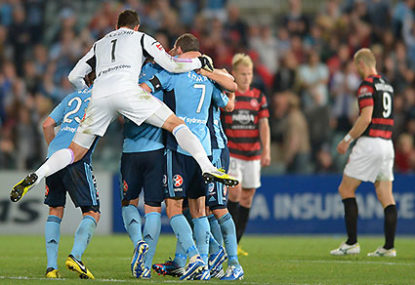Frank Lowy said in 2004 the development of a national domestic competition was essential. What was, and still is, missing is football knowledge at park levels. Many issues are affected by this, from keeping good players to people watching and understanding football.
FFA understood that to get people to watch and stay in the game, technical standards needed to be improved and explained.
Football’s management was forced to take a long hard look at itself and decide how to grow the game. Technical improvement programs were expanded.
The quality of football and the understanding of how to play are being spread.
Football has achieved this on very small budgets. From a very strong position in 2003 in terms of player numbers to today when we can’t get enough fields.
Essentially, FFA spend over a third of its money on these technical junior programs – not marketing, not player salaries.
The payoff is only now starting to come. Each A-League team today has a number of junior players coming out of these programs.
Another goal was to stop players aged 12 to 16 from leaving the sport. Football wanted to keep its best.
The following was undertaken, to both keep players and spread technical knowledge:
• Establishment of a youth league team for each A-League club.
• Establishments of national player identification programs, hopefully taking out bias in player selection.
• Establishment of national training systems so that players coming through the system they decent training.
• Identification of the 60 best junior players in Australia between 12 and 16 and then developing a coaching system for these players.
• Establishment of a national under-15 side.
• Establishment of state under-15 sides.
• Development of the small-sided no score, skill games for all competitions under 10; thus, in under-10 and under park games, no score is kept and player numbers are reduced and are on small fields, to give kids more time on the park. This was seen as being needed to improve quality in later years.
The result was that considerably more players stayed, and women’s football exploded in numbers such that netball is starting to get worried about the drain of players to football.
Today, according to the CSIRO, football has close to 900,000 registered winter park players.
The fractured nature of our structure was another major issue.
The FFA has created a state-based National Premier League across the country with promotion and regulation, meaning the tier below the A-League is structured, with each team required to have a technical director qualified to a certain FIFA level.
While this may take some money away from the A-League, it is seen as being critical in creating a pool of players and creates over 100 academies around the country.
Plus, it gives players reasons to stay in football.
The FFA Cup, with over 800 park teams invited to play and broadcasters and sponsors being involved, again brings in the park teams into the national setup to feel a part of the family.
Other developments include the establishment of a National Indigenous Kids academy, higher technical qualifications being required by all coaches, and massive inroads into the private school system, with schools creating football academies akin to what they have developed in rugby.
Football has spent over a third of its revenue on developing technical skills at lower levels, and is planning to now involve every single park team in Australia with the A-League.
To grow in the future, free-to-air coverage was increased. It came with a reduction to revenue. However, it is seen as necessary to grow the game and spread more technical knowledge.
In four years’ time, football will have over a million registered park players, with over one hundred academies, 800 park teams involved in a national competition and a national second tier competition with promotion and regulation.
Remember the howls when we lost two teams from 12 to 10 and the clubs demanded more money? FFA held firm and let the competition shrink, and kept putting more of their funds into junior development than the A-League.
The investment in juniors today represents maybe 25 percent of the players in the A-League; they are young, skilful, and will bring crowds.
It’s been a bumpy ride and I am sure many challenges lie ahead. However, we have never had such a set-up.
We have district park teams growing into National Premier League teams, who are required to have qualified coaching directors, an Australia Cup, with the A-League free-to-air.
Its feeling better each year and well done to all involved.






























































































